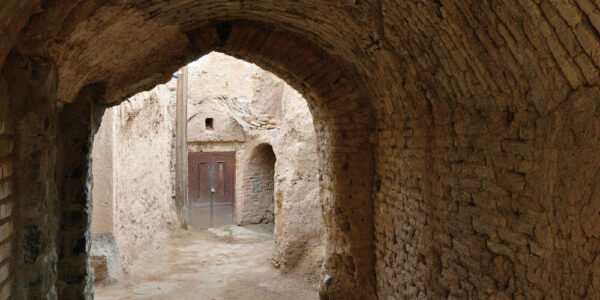Florence surveyed her surroundings incredulously. Their two-story mud hut in Maragha, Persia (modern-day Iran), was nice by local standards. She had a small kitchen with windows that allowed a light breeze to filter through; the first floor would be a perfect place to hold meetings, and the second floor provided two additional rooms, a living room and a bedroom. But how, she wondered, would she ever be able to keep the mud floors and walls clean? Her eyes grew misty as she thought of home and her family. She felt alone here, so very alone.
Her new husband, Frank Oster, was accustomed to missionary life, having already been in the field for four years. Florence well remembered their first encounter. They had been sitting side by side at a Foreign Mission Band meeting organized by Professor Harry Washburn at Walla Walla College, in the United States. Independently they pledged that if it was God’s will, they would become foreign missionaries. A casual friendship blossomed between them—until Frank left as a missionary in 1909.
With the new vision for foreign missions that emerged after the 1901 General Conference session, many young people had been chosen for overseas service, including Frank. He and his friend, Henry Dirksen, were the first resident Adventist missionaries to enter Persia. They understood, as did most missionaries from the United States, that their commitment was long-term. They expected to be in the field for life.
Life as a Missionary Family
Frank and Florence’s relationship began in earnest after he left, courtesy of the post office. Through a flurry of letters they knew that they were meant to be together, united as partners in service. They married in London, where Florence’s parents lived, then caught a ship to spend their honeymoon en route to Persia. It was 1913.
The introduction of To Persia, With Love, a biographical sketch of the Oster’s work in Iran, contains these words: “Islam . . . has from its beginnings elicited a level of fervor and loyalty among its people that has been seen only occasionally in other religions. Here the missionary task has proved to be perhaps the most difficult in the whole world. For the first fifty years of Seventh-day Adventist work in Persia (beginning in 1911) there were a total of twenty-nine missionaries. Frank and Florence Oster worked there alone for eleven years (1914-1925).”1
Ultimately, Frank worked for 35 years in the Middle East, 27 of which were in Persia.
The Osters created a niche for themselves in Persia. Frank held meetings and Bible studies in their home, using Sabbath School materials.2 Florence busied herself with learning Turkish, the common language in the area, using the Bible as her textbook. She soon gathered a group of neighborhood girls to teach them English. While the girls learned English, she practiced her Turkish by expounding on the Bible verses she’d been reading. A few of the girls began keeping the Sabbath as a result of her language skills and willingness to embrace her neighbors.
Life was not easy for the Osters. They battled severe illness, fled Kurdish raiders during World War I, lost two children to disease, survived on limited funds, and faced loneliness on a daily basis. But they were faithful to their post of duty. When letters came from the General Conference offering them furloughs, they chose to stay in the field. It seemed that after all the years they had labored, the church was just on the verge of springing to life.3 Florence is quoted as saying: “No, Frank. God’s work will suffer if we leave. We can’t go now.”4
The Osters established schools, fed and clothed orphans, ministered to refugees, and little by little grew the church in the Middle East one person at a time. By the time they were transferred to Istanbul, Turkey, “the mission work had moved from pioneer ‘zero’ conditions to a stable consolidated mission with a competent staff of national and European workers.”5
When they did finally return home, it was because of World War II and mandatory orders to evacuate. “They had given thirty-five years of their lives to the pioneering of the most ancient lands in the world. There had been high points and many low ones, too. And in retrospect it seemed that much time and energy had been given for pitifully small results—if one were to consider just the numbers.”6
An Enduring Legacy
The Osters might have been tempted to think that their sacrifice was in vain, but in the final pages of their life story, they wouldn’t have changed a thing. Florence was once asked: “Has the burden been too great? Was the price of it all too high? Could you have given your life and talents to some better cause? ‘No—a thousand times, no!’” she answered. “Living in commitment to God’s will for all of these years, [they saw] His guiding hand too many times and . . . felt His Spirit’s soothing comfort too often to wish that anything had been otherwise.”7
The flicker of spiritual flame the Osters lit was all but swept away by the Iranian revolution in the 1970s. The “work in that ancient land remains unfinished, and the challenge is even greater than before. How God’s work shall be finished . . . remains in the hands of the new pioneers, working under the blessing of divine Providence.”8
Who will take up the banner and follow in their steps, doing hard things for God?
1 Kenneth Oster and Dorothy Minchin-Comm, To Persia, With Love (Mountain View, Calif.: Pacific Press Pub. Assn., 1980), pp. 9, 10.
2 Advent Review and Sabbath Herald, August 7, 1952, documents.adventistarchives.org/Periodicals/ARAI/ARAI19520807-V129-32.pdf.
3 Kenneth Oster and Dorothy Minchin-Comm, To Persia, With Love, p. 69.
4 Ibid.
5 Ibid, p. 160.
6 Ibid., p. 188.
7 Ibid., p. 190.
8 Ibid., p. 4.



